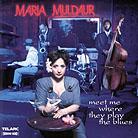August 1999
In fact, Meet Me Where They Play the Blues, is her third recording for Telarc, and for old-time’s sake I wish it were better. Song selection is interesting (except for the first two cuts), the studio musicians are top-notch and Muldaur seems to have a grasp of "cool blues," as the album’s style of music is characterized. Why then is the recording less than the sum of its parts? Perhaps, the album’s original concept was sabotaged by the untimely death of Charles Brown, a creator of cool blues, to whom the album was dedicated and who was to sing and play piano in his own honor. Brown’s rapid decline during the production phase required setting up a mini-studio in his nursing home and recording him there. His duet with Muldaur on "Gee, Baby, Ain’t I Good to You," offers a glimpse of a recording that should have been but wasn’t. Secondly, the album seems overly constrained, even by cool-blues standards. It starts off lifelessly with the soporific songs "Soothe Me" and "I Wanna Be Loved," back to back, leading to a cumulative listlessness which the rest of the album struggles to overcome. Cut three, which dubs in the voice of soon-to-be-deceased Mr. Brown, ups the temperature somewhat, while the next song, "It Ain’t the Meat, It’s the Motion," is a frustrating near-miss. Interestingly, Muldaur recorded the same tune in 1974 before she became a Christian singer. I wish I had the earlier album on hand to compare the two songs for carnality. Track seven, John Hiatt’s "It Feels Like Rain," features Muldaur at her current best, with a hint of the smoldering seductress. However, even this cut, which could have been a contender, peters out instead of peaks out. This raises a third speculation why the album seems constricted. Maybe 30 years of singing have taken their toll on Muldaur’s larynx. Her voice could be too frail to accompany big dynamics and hot playing. The sidemen tiptoe around her vocals and the arranger avoids the big finish wherever possible. If there’s no "belt" left in the well-used voice, maybe Muldaur should consider a less purist approach to recording and reach for a more commercial sound, á la Cher. (Just kidding.) Actually, I think a honkier-tonk piano and a raunchier guitar would have served her grainy vocals better than the super-clean accompaniment on this outing. Although I have long admired Telarc’s classical recordings, this was my first exposure to their popular music efforts. I hope future such releases will adopt a slightly more hang-loose approach. It would be wonderful if Telarc’s high production values could coalesce with unrestrained playing and singing to provide a five-square listening experience. As for Muldaur’s Blues album, I’m sorry to say it feels like rain to me. GO BACK TO: |
 Maria Muldaur - Meet Me
Where They Play the Blues
Maria Muldaur - Meet Me
Where They Play the Blues![[Reviewed on CD]](../format/regcd.gif) The
name Maria Muldaur conjures up images of a ravishingly beautiful Italian-American whose
quirky voice on the suggestive hit "Midnight at the Oasis" defined the
discotheque sound of the ’70s before it became "disco." After smashing
early success, which included four albums in five years, Ms. Muldaur dropped below radar
range for most of us. When I first saw her name attached to Telarc’s Meet Me Where
They Play the Blues, I assumed she had made a comeback album. Little did I know Ms.
Muldaur has been a working musician for over three decades, doing guest appearances and
back-up vocals on dozens of albums.
The
name Maria Muldaur conjures up images of a ravishingly beautiful Italian-American whose
quirky voice on the suggestive hit "Midnight at the Oasis" defined the
discotheque sound of the ’70s before it became "disco." After smashing
early success, which included four albums in five years, Ms. Muldaur dropped below radar
range for most of us. When I first saw her name attached to Telarc’s Meet Me Where
They Play the Blues, I assumed she had made a comeback album. Little did I know Ms.
Muldaur has been a working musician for over three decades, doing guest appearances and
back-up vocals on dozens of albums.